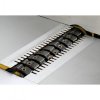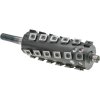I'm going to be buying a 15" planer, probably Grizzly. There are 2 models, one with a spiral cutter head and one with a helical cutter head.
I'm looking to see what the difference in cut quality is, if any, between the two. Does either spiral or helical stand out as giving a smoother cut with less finish sanding or would it be a better idea to buy a cheaper 15" model (about half the price) with straight knives and then change the cutter to Byrd Shelix or comparable cutter?
I'm looking to see what the difference in cut quality is, if any, between the two. Does either spiral or helical stand out as giving a smoother cut with less finish sanding or would it be a better idea to buy a cheaper 15" model (about half the price) with straight knives and then change the cutter to Byrd Shelix or comparable cutter?


